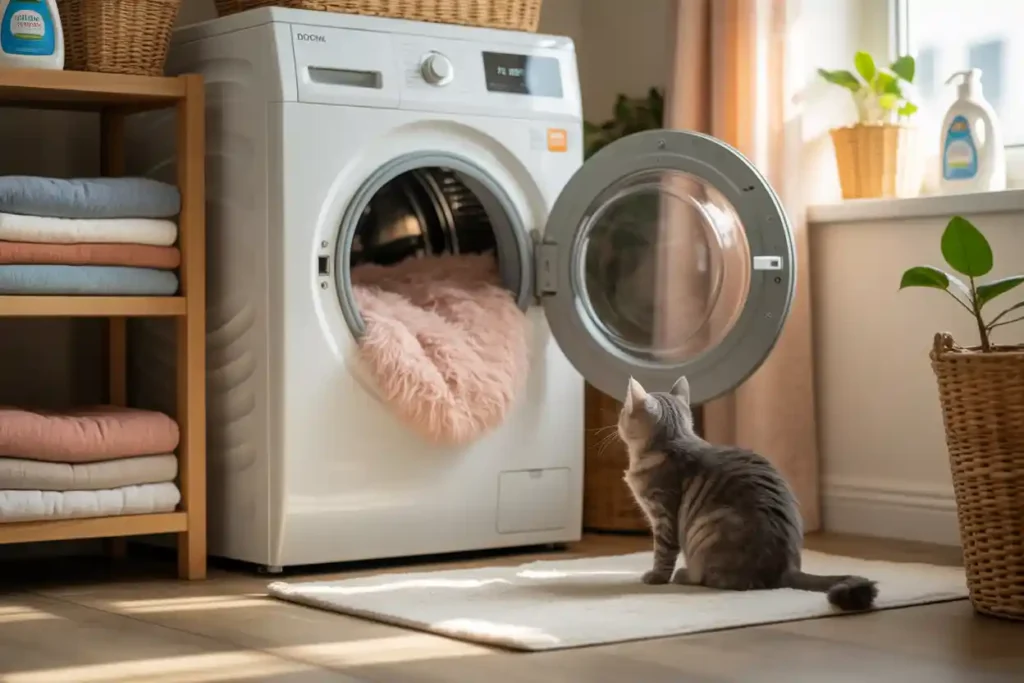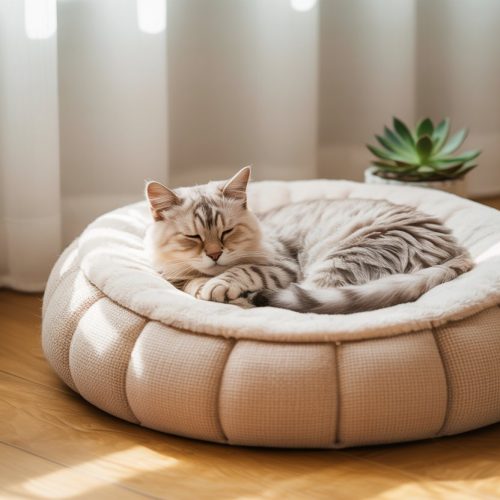
Cats are known for their love of cleanliness, but what about the places where they sleep? Whether your feline friend prefers a plush donut bed or a simple fleece blanket, the question arises: Can you wash a cat bed in the washing machine? The short answer is yes—but with some important precautions.
This guide will walk you through everything you need to know about safely washing cat beds, maintaining hygiene, and ensuring your cat’s comfort while keeping bacteria, odors, and allergens at bay.
🐾 Why It’s Important to Wash Your Cat’s Bed
Before diving into the “how,” it’s essential to understand the “why.” A cat’s bed is more than just a cozy corner—it’s also a collection point for fur, dander, saliva, and sometimes, even accidents. Over time, these elements can cause:
- Unpleasant odors
- Bacterial growth
- Allergen build-up
- Flea or mite infestations
- Discomfort for your cat
Even if the bed appears clean on the surface, hidden particles can still linger deep within the fabric or padding. Regular washing ensures your cat’s environment stays healthy and fresh—and it also helps extend the life of the bed.
🔍 Can All Cat Beds Be Washed in the Machine?
Not necessarily. While many modern cat beds are machine washable, some are not. The first and most crucial step is to check the care label or manufacturer’s instructions. This tag usually tells you whether the bed is:
- Machine washable
- Hand wash only
- Surface clean only
- Dry clean recommended
Ignoring these instructions can damage the bed’s materials, distort its shape, or even reduce its comfort level. So, always read the label before proceeding.
🧺 Machine Washing vs. Hand Washing
Let’s break down when to machine wash and when to hand wash a cat bed:
✅ Ideal for Machine Wash:
- Beds with removable covers
- Beds made from polyester, fleece, or cotton
- Beds labeled as “machine washable”
🛑 Should Be Hand Washed or Spot Cleaned:
- Beds with memory foam or orthopedic padding
- Beds with glued or stitched-in padding that might break in the machine
- Beds with delicate embellishments or fragile seams
If your cat’s bed falls into the second category, don’t worry—you can still clean it effectively with a different approach.
🧼 How to Wash a Cat Bed in the Washing Machine: Step-by-Step Guide
If your cat bed is deemed machine-safe, follow this step-by-step method to ensure thorough cleaning without compromising quality.
1. Remove Loose Hair and Debris
Before anything else, use a vacuum, lint roller, or brush to remove as much fur and debris as possible. This will reduce hair buildup in your washing machine and allow detergent to penetrate more deeply into the fabric.
2. Pre-Treat Any Stains
For visible stains or strong odors (like urine or vomit), spot-treat the area with a pet-safe stain remover or a mix of white vinegar and water. Let it sit for 10–15 minutes before washing.
3. Choose a Gentle Detergent
Always opt for a fragrance-free, pet-safe detergent. Cats have a powerful sense of smell and sensitive skin. Strong detergents or artificial fragrances can irritate or deter them from using the bed.
4. Select the Right Cycle
Set your washing machine to a gentle or delicate cycle with cold or lukewarm water. Hot water might shrink the fabric or damage internal padding.
5. Avoid Harsh Additives
Do not use bleach, fabric softeners, or dryer sheets. These can leave chemical residues that are harmful to your cat and may break down the material over time.
6. Drying the Bed
If the label allows, tumble dry on low heat. Otherwise, hang the bed outdoors in the sun. Sunlight has natural antibacterial properties and helps eliminate lingering odors.
♻️ How Often Should You Wash a Cat Bed?
There’s no one-size-fits-all rule, but here are some general guidelines:
- Every 1–2 weeks: For active or outdoor cats who shed or soil their bedding more frequently.
- Every 3–4 weeks: For indoor cats with minimal mess and shedding.
- Immediately after any accidents: If the bed has been soiled by vomit, urine, or food.
Keeping a backup bed on hand can be a lifesaver. While one is in the wash, your cat still has a cozy place to rest.
💡 What If the Bed Isn’t Machine Washable?
Not all beds are created equal. If your cat bed can’t go in the washer, here’s how to maintain it properly:
➤ Spot Cleaning
Use a soft cloth, warm water, and a mild soap to dab stained areas. Avoid soaking the entire bed, especially if it contains foam or non-waterproof padding.
➤ Vacuuming
Weekly vacuuming helps remove fur, crumbs, and allergens that build up in crevices.
➤ Sun Exposure
Lay the bed in direct sunlight occasionally to kill bacteria and reduce odors.
➤ Baking Soda Deodorizer
Sprinkle baking soda over the bed, let it sit for 15–20 minutes, then vacuum it off. This absorbs smells without using harsh chemicals.
👃 Controlling Odor in Cat Bedding
No one wants their home to smell like a litter box—or a pet bed. Here’s how to manage odor naturally:
- Wash regularly using safe detergents
- Dry completely to prevent mildew
- Use odor-neutralizing sprays that are safe for pets
- Keep the surrounding area clean, especially if the bed is near a litter box or food bowl
- Use washable liners or covers that can be changed frequently
🌿 Choosing the Right Bed for Easy Cleaning
If you’re still in the market for a new cat bed, consider choosing one that’s made specifically for easy maintenance. Look for:
- Removable, zippered covers
- Machine-washable materials
- Water-resistant or anti-microbial fabrics
- Durable stitching and padding that won’t clump in the wash
These features not only make your life easier but also extend the life of the product and keep your cat healthier.
🚫 Common Mistakes to Avoid
Even the most well-meaning pet owners can make these cleaning mistakes:
- Using hot water can damage fabric
- Using scented detergents that irritate your cat’s skin
- Forgetting to dry thoroughly, leading to mold or mildew
- Washing too infrequently, especially in summer
- Ignoring non-washable beds, which can become breeding grounds for bacteria
Avoiding these mistakes ensures your cat has a safe, pleasant place to rest.
🐱 Why Your Cat Might Stop Using Their Bed
Cats are picky creatures. If they suddenly refuse to sleep in their bed, it could be due to:
- Residual detergent smells
- Unfamiliar scents
- Uncomfortable texture after washing
- Temperature change (too hot or too cold)
To fix this, try washing the bed again with a scent-free rinse or placing a piece of your worn clothing on it to transfer your scent. Familiarity can be comforting for your cat.
🧠 Final Thoughts
So, can you put a cat bed in the washing machine? Yes—but it depends on the bed. Always check the label, use gentle settings, and prioritize your cat’s safety by avoiding strong chemicals. With regular cleaning and the right care, your cat’s bed can remain a cozy, hygienic haven that they return to again and again.
A clean bed means a happy cat—and a happier home for you, too.






